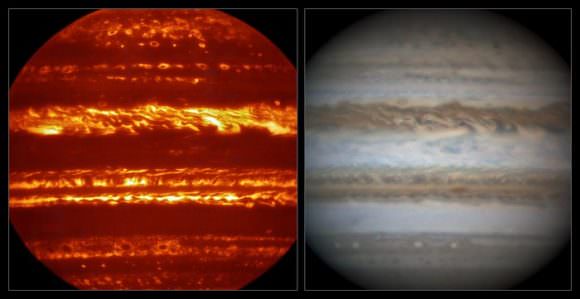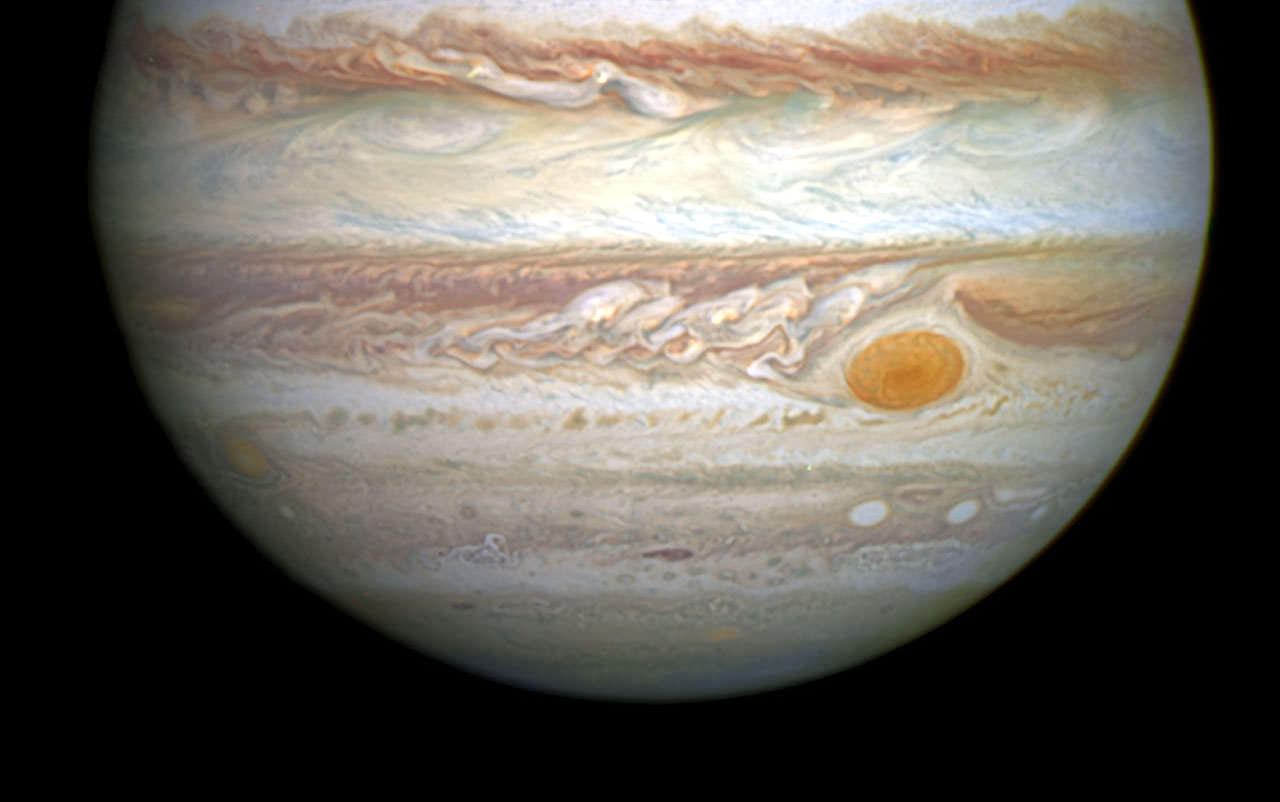Welcome to a new series here at Universe Today! In this segment, we will be taking a look at the weather on other planets. First up, we take a look at the “King of Planets” – Jupiter!
One of the most obvious facts about the gas giant Jupiter is its immense size. With a mean radius of 69,911 ± 6 km (43441 mi) and a mass of 1.8986 × 1027 kg, Jupiter is almost 11 times the size of Earth, and just under 318 times Earth’s massive. But this “go big or go home” attitude extends far beyond the planet’s size.
When it comes to weather patterns, Jupiter is also an exercise in extremes. The planet experiences storms that can grow to thousands of kilometers in diameter in the space of a few hours. The planet also experiences windstorms, lightning, and auroras in some areas. In fact, the weather on Jupiter is so extreme that it can be seen from space!
Jupiter’s Atmosphere:
Jupiter is composed primarily of gaseous and liquid matter. It is the largest of the gas giants, and like them, is divided between a gaseous outer atmosphere and an interior that is made up of denser materials. It’s upper atmosphere is composed of about 88–92% hydrogen and 8–12% helium by percent volume of gas molecules, and approx. 75% hydrogen and 24% helium by mass, with the remaining one percent consisting of other elements.

The atmosphere contains trace amounts of methane, water vapor, ammonia, and silicon-based compounds as well as trace amounts of benzene and other hydrocarbons. There are also traces of carbon, ethane, hydrogen sulfide, neon, oxygen, phosphine, and sulfur. Crystals of frozen ammonia have also been observed in the outermost layer of the atmosphere.
Jupiter is perpetually covered with clouds that are composed of these ammonia crystals, and possibly ammonium hydrosulfide. These clouds are located in the tropopause and are arranged into bands of different latitudes, known as “tropical regions”. The cloud layer is only about 50 km (31 mi) deep, and consists of at least two decks of clouds: a thick lower deck and a thin clearer region.
These clouds are also what gives the planet is banded appearance, with clouds of yellow, brown and white circling the surface rapidly. These bands are produced by air flowing in different directions at various latitudes. Lighter-hued areas where the atmosphere rises are called zones. Darker regions where air falls are called belts. When these opposing flows interact, storms and turbulence appear (aka. “zonal jets”).
The Great Red Spot:
As noted already, Jupiter experiences violent storms, which often take the form of zonal jets. In these weather fronts, wind speeds of 100 m/s (360 km/h) are common. But wind storms on the mighty planet can reach as high as 620 kph (385 mph). These storms can form within hours and become thousands of kilometers in diameter overnight.

One storm, the Great Red Spot, has been raging since at least the late 1600s – when Italian astronomer Giovanni Cassini made the first recorded observation of it. The storm has been shrinking and expanding throughout its history; but in 2012, it was suggested that the Giant Red Spot might eventually disappear.
This storm is one of the best known features in the Solar System. It is located 22° south of the equator and reaching sizes of up to 40,000 km across, it is larger in diameter than Earth. The storm rotates in a counter-clockwise motion, making it an anti-cyclonic storm.
It rotates differently than the rest of the atmosphere: sometimes faster and sometimes slower. During its recorded history it has traveled several times around the planet relative to any fixed position below it.
Meteorological Phenomena:
Jupiter also experience weather phenomena that are similar to those of Earth. These lightning storms, which have been detected in Jupiter’s atmosphere. Scientists believe that these may be due to a thin layer of water clouds underlying the ammonia layer.

The presence of this water layer (and it’s polarity) would create the charge separation needed for lightning to occur. Observations of these electrical discharges indicate that they can be up to a thousand times as powerful as those observed here on the Earth.
Like Earth, Jupiter also experiences auroras near its northern and southern poles. But on Jupiter, the auroral activity is much more intense and rarely ever stops. The intense radiation, Jupiter’s powerful magnetic field, and the abundance of material from Io’s volcanoes that react with Jupiter’s ionosphere, create a light show that is truly spectacular.
What it comes down to is that Jupiter experiences weather that is similar to what we experience here on Earth. This includes wind storms, lightning, and auroras in both the northern and southern polar regions. The only difference is, in Jupiter’s case, the size and scale of the weather is much, much larger!
On Jupiter, as with everything else on the “King of Planets”, the weather is the result of titanic forces that produce some seriously powerful results. If any of these were to happen here on Earth, the results would be disasterous!
We have written many interesting articles about Jupiter here at Universe Today. Here’s Ten Interesting Facts About Jupiter, How Long Does it take to get to Jupiter?, How Much Bigger is Jupiter than Earth?, How Strong is Jupiter’s Gravity?, and Jupiter Compared to Earth.
For more information, check out NASA’s Solar System Exploration – Jupiter, and the facts about Jupiter from Space Facts.
Astronomy Cast also has episodes dedicated to Jupiter – Episode 56: Jupiter, and Episode 57: Jupiter’s Moons.
Sources:


If a planet experience storms and contains water vapor in its atmosphere. Is it not a big chance that it supports conditions for life? Is there no a big possibility that it contains water?